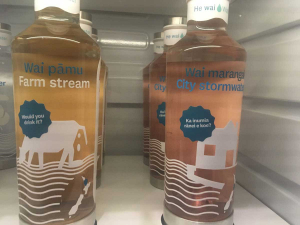Dairy farmers are venting their frustration at national museum Te Papa for its “anti-farming narrative”.
It stems from a bottle of murky water on display at the museum: the bottle is labelled “Farm Stream”. An image on the bottle shows a cow defecating in a stream.
National agriculture spokesman Todd Muller earlier this week tweeted a photo captioned “Te Papa water quality display presents this as water from a typical farm stream. What do you think? Any farmers want to post a bottle of water from their farm streams to compare?”
Many farmers took to social media to blast Te Papa, who tweeted in reply to Muller’s tweet: “this display shows that water quality can't be judged on its appearance.
“The dairy stream example is one of 9, and sits right next to a city storm water bottle and below a forestry stream water bottle.”
However, dairy farmers aren’t convinced.
“It’s incredibly disappointing to see our national museum Te Papa reinforcing an overly simplistic anti-farming narrative that negatively impacts the public’s perception of New Zealand farmers and the dairy sector” DairyNZ chief executive Dr Tim Mackle says.
“The water in their display is not reflective of what your average farm stream in NZ would look like. If you don’t believe me, you just need to look at the countless videos and pictures farmers have posted to social media to correct the perception.
“Farmers were right in demanding to know when and where this water was taken from. Te Papa have since confessed that the water wasn’t actually from a farm at all but was made up in a back room using brown dye.
“It’s not just about the quality of the water in the bottle either” Mackle added.
He says the imagery on the bottle of a cow standing in water defecating is highly deceptive and entirely out of step with the reality of dairy farming in New Zealand today.
“Farmers who have done the right thing and voluntarily invested their time and their money to fence off waterways and plant riparian strips deserve better than this from their national museum.”
Dairy farmers have fenced over 24,744km of waterways.


















